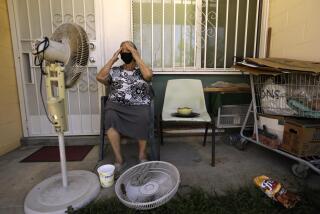Running Hot and Cold
- Share via
On the job at the North Hollywood Ice Co., Mark Ladomade is in and out of walk-in freezers all night long, loading up bags of ice for deliveries. No one would blame him for working in ski gear.
But on most days he wears shorts. And doesn’t feel cold.
“I have on this jacket,” he says nonchalantly during a recent shift, pointing to a black, medium-weight Windbreaker atop salmon-colored shorts.
The mere mention of wearing shorts in freezing weather would probably send Jackie Braunstein of Santa Monica searching for her gloves.
“My hands are always freezing,” she says. “When I get in the car, the first thing I do is turn on the heater. When I pick up friends, the first thing they say is, ‘How do your windows work?’ ”
Why do some people shiver when others breeze around like it’s the Garden of Eden?
“I think it’s a great subject,” says Dr. Robert Heller, an internist at Brotman Medical Center in Culver City and UCLA assistant clinical professor of medicine. But like everything in medicine, it’s not nailed down.
“We don’t totally understand the temperature regulation system in the body,” he says.
What is known is that body temperature is regulated by the hypo-thalamus in the brain, the body’s “thermostat.”
Temperature sensors within the skin send a message to the hypothalamus, which in turn sends out its own message, explains Dr. Glenn Braunstein, chairman of the department of medicine at Cedars-Sinai Medical Center and UCLA professor of medicine, who usually wears shorts and a T-shirt to accompany his bundled-up wife, Jackie, on walks.
When you’re feeling warm, the message is to dilate the blood vessels and to sweat.
When you’re feeling cold, the message is to constrict the blood vessels and to stimulate the muscles to shiver and increase heat production.
Certain medical conditions--infections, tumors, fever and thyroid problems--can produce warmer or colder than normal body temps. But beyond that, it’s anyone’s guess why one person will be a shiverer and another will be a shorts-wearer, though doctors do cite “biologic variability.”
Thinner people often feel the cold more than heavier people. “If you have a lot of body fat, you tend to be able to retain heat a little more,” Braunstein says.
Using that guideline, men should feel the cold more than women, who usually have a higher percentage of body fat than men. But doctors say most of their patients complaining of being cold are women.
Whatever their weight, active people often stay warmer than sedentary people. That helps explain why children can romp around without much on and not complain of being cold while their parents shiver and fret about their offspring catching pneumonia.
Not that you have to be marathon material to be classified as nonsedentary.
“You’ve seen people sit and they just sit,” Heller says. “But others cross and uncross their legs. They’re more squiggly people, more hyperactive, more dynamic. They use a lot of gestures”--and therefore might be warmer.
Very active people who work out a lot might have a higher metabolic rate, and thus feel warmer, says Dr. Frederick Ziel, an internist and endocrinologist at Kaiser Permanente, Woodland Hills, and UCLA assistant clinical professor of medicine.
And people who have good blood circulation at skin level are also likely to feel warmer.
Age, by itself, probably doesn’t make a person more intolerant of cold, Heller says. But with age some people become more sedentary and they lose weight, and that can play a role.
Whether you feel cold or hot might also depend on the time of day, since body temperature naturally goes up and down. A temperature range of about 96 to 99 degrees Fahrenheit is normal, Heller says. “Usually the lowest temperature occurs in the middle of the night, between about 2 a.m. and 4 a.m. The highest is from about 6 to 10 p.m. when you are moving around.”
In hot weather, normal body temperature can go up from a half to one degree Fahrenheit, without a person having a fever, Heller adds.
Given all these variables, chances are excellent that office mates and family members will have mismatched thermostats.
Says one Los Angeles worker of her office mate: “She comes in with short sleeves and lightweight clothing. I’ll have on a sweater, gloves and a scarf.”
But sometimes people find a perfect match. Heller’s wife, cookbook author Cheryl Sindell, says she and her husband both prefer to keep windows open year-round. “Our daughter, who’s 14, is kind of like us,” she adds. So there are no thermostat debates in their house--at least not until Sindell’s Chicago in-laws come to visit.
They don’t greet L.A.’s balmy breezes with open (much less bare) arms.
“My mother-in-law has worn a muffler at the dinner table here,” Sindell says. “When I go there, I’m always trying to find a window to open.”
If you keep your house at a certain temperature and visit a house kept colder or warmer, it takes some time to adjust.
Adaptation might explain why Ladomade can comfortably wear shorts at the ice company. They’ve been preferred attire, he says, ever since high school.
But even he bundles up sometimes--while skiing, for instance. Otherwise, it’s mostly shorts.
“People do notice,” he says.


